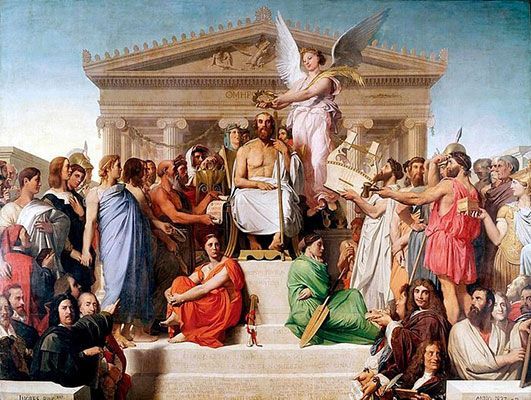Summary of Nicolas Poussin
A Frenchman who spent almost his entire working life in Rome, Nicolas Poussin is known for popularizing elements from Greek and Roman Classical art through his works. He specialized in scenes from the Bible, ancient history, and mythology and his canvases are revered for their narrative intensity and their ordered approach to composition. Poussin is also admired for his strong use of color and rational and ordered, rather than emotional, approach to painting. He was able to demonstrate that art could be an intellectual pursuit and through his layering of meaning he produced paintings of extraordinary dramatic depth and allegorical complexity. Towards the latter part of his career, Poussin's art submitted to a further transformation as he diversified to depict landscapes and a series of allegories that were expressed through the harmonious forces of nature. Though his reputation declined in the first half of the 18th century, Poussin enjoyed something of a rebirth in the second half of that century when the Neoclassicist Jacques-Louis David and his followers championed Poussin's style above all other Classicists. Poussin's reputation has remained buoyant ever since.
Accomplishments
- Initially influenced by the Venetian Renaissance and Titian's masterful use of sensual color, Poussin began to develop the classical approach for which he is best known. Though like all Baroque artists, he depicted dramatic moments with mythological and classical themes, he favored a rational and conceptual approach to composition and used archeologically accurate settings and idealized the human figure while employing rhetorical gestures that were appropriate to the subject matter and expressed human emotion.
- Poussin developed and practiced a highly symmetric approach. His precise geometrical organization, coupled with visual allegories, borrowed from the Hellenic philosophy of Stoicism. Poussin wanted to convey universal ideas about human experience and existence. He believed that we are all subject to forces outside our control and the only way to a contented existence was through logical thought and personal self-control.
- Drawing upon the modes of ancient Greek music and rhetoric, Poussin developed what came to be called his "theory of the modes." In ancient Greece, the concept of the mode was that it was a rational element that could be measured and had a recognizable emotional affect. Poussin felt a similar process of analytical and rational choice should govern in choosing a painting's formal elements to express the emotion appropriate to the subject matter.
- In his later paintings Poussin turned to a darker palette and freer compositional formations to represent the relationship between the natural environment and the mind. He painted expressive landscapes as a way of communicating conflicted or untamed human emotions. Poussin hoped that this would bring about a higher cerebral connection with his spectator.
Important Art by Nicolas Poussin
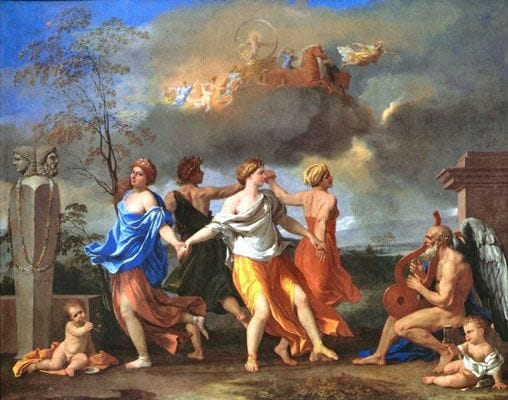
Dance to the Music of Time
Dance to the Music of Time was commissioned by the future Pope Clement IX, Giulio Rospigliosi, Poussin's most important patron during his early years in Rome. Rospigliosi was also a gifted opera lyricist and the painting has been read as reflecting the patron's interest in music (and dance). At the same time, this painting is seen as one of Poussin's most famous allegorical works. It represents the theme of the passing of time and the cycles of life; the four figures representing the wheel of human fortune: Poverty, Labor, Riches, and Pleasure. Labor leads one out of poverty onto riches which lead to pleasure. To become spoiled by the excesses of pleasure, however, only leads one back to poverty.
The figures' differences are represented through their clothing and positioning (Poverty being the male figure in black with his back fully turned towards the spectator). The elderly, bearded man on the right-hand side is recognizable as Father Time, though, possibly to please Rospigliosi, Poussin has swapped his traditional scythe for Orpheus's lyre. To reinforce the themes of the painting, Poussin places one small putto with an hour glass at Time's feet, while mirroring him on the left of the picture plane, another putto is shown blowing bubbles (a pictorial symbol of the fragility of man according to ancient mythology). Above in the heavens, meanwhile, we see Apollo riding his chariot (a symbol of the rising sun) indicating the passing of days. Bacchus, the God of wine and intoxication, finally, represented as both a young and old man in the herm on the left, faces Pleasure (possibly by way of a warning).
In the 1630s Poussin often depicted the theme of dance. As theatrical critic Alastair Macaulay noted "part of what fascinated him in classical art was its depiction of dance," and as Macaulay added, "The dancing he drew and painted is all mythological (including Old Testament subjects) ... how keenly he derived dance ideas from three Graeco-Roman masterpieces from the first century BCE and second century CE: the "Gaeta Vase", the Borghese vase, and the 'Borghese Dancers' relief." Through Poussin's fusion of different mythological and representative figures, this painting demands that the spectator call on his/her intellect to decode its meaning. Indeed, though he represented myths in many of his narrative works, Dance to the Music of Time shows Poussin's aspiration to use narrative painting to also communicate classical concepts and ideals.
Oil on canvas - Wallace Collection, London
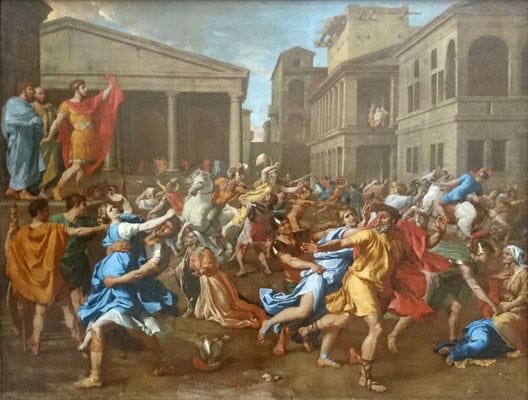
The Abduction of the Sabine Women
In this striking, and influential, painting (of which there are two versions) Poussin drew on Roman mythology to depict a scene of mass panic in which a man (Romulus) gives the order for the young women in this town square to be seized by Roman soldiers. This story was very popular during the Renaissance and was painted by many painters, and later, several painters used Poussin's work as a study piece. Degas, for instance, would copy the version of the painting hanging in the Louvre, noting (in 1853) that "it is only after proving yourself a good copyist that you should reasonably be permitted to draw a radish from nature."
In this, the second version, Poussin focusses on the architecture and setting in order to contrast the disorder of the crowd with the apparent simplicity of the buildings. Though at first the painting may look overcrowded, once the spectator follows each individual confrontation, it becomes clear that Poussin meticulously planned the position of each person. His preparatory sketches reveal that he worked with small three-dimensional wax figurines to stage the scene and to create each figure's rhetorical gestures to express the deep emotion of each terrifying and tragic encounter. At the left, dominating the scene, Romulus raises his left arm while grasping his imperial red cloak to give the signal for his soldiers to attack. His right arm wafts behind him, as his gesture creates a sense of a character that is both desultory and imperious. In the plaza below him, a young woman lifts her arms, her left as if calling for aid, and her right hopelessly trying to push her abductor away. Similar scenes occur throughout the scene, while the perspective of the buildings draws our eye further into the painting, as if to suggest that these atrocities may be happening throughout the city. The sumptuous colors of the robes offer a ghoulish contrast against the aggressions of the Roman soldiers.
A number of Baroque artists depicted this event from Roman legend. Art historian Rebecca Zorach noted how in "Baroque versions, we can ... see that the theme was flexible enough to make different moral arguments. Poussin's two versions of the Rape of the Sabine Women suggest, on the one hand, an embrace of nationalist myth and, on the other its critique." She noted how this second version, "contains both civic and domestic architecture and female onlookers...Romulus is a less appealing figure, his posture slack. The Roman soldiers display exaggerated facial features that, in the Baroque facial grammar, make them look villainous. The painting appears almost as a parody of the earlier version; it makes the rough violence inherent in the story plain."
Oil on canvas - Louvre Museum, Paris
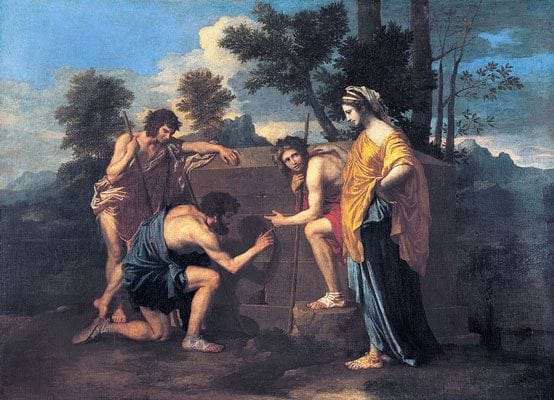
Et In Arcadia Ego
Rospigliosi also commissioned this piece, also known as The Arcadian Shepherds, which is quite possibly Poussin's most famous masterpiece. Four shepherds stand around a tomb in this pastoral scene. The concept of an Arcadia comes from the idealized location named by the poet Virgil; it is supposed to denote a beautiful country paradise. However, Poussin contrasts this blissful idyll with the presence of a tomb. The crouching figure traces the words "Et in Arcadia Ego" meaning, "Even in Arcadia; I am there" suggesting that death knows no bounds; even in the most heavenly of settings. The shepherd on the right, who looks away and out of the frame, appears shocked and nervous, as if he is struggling to come to terms with his own mortality.
Like Dance to the Music of Time, Poussin uses his painting to communicate universal ideas about human experience through visual allegories. Here, we see Poussin's interest in the Hellenistic philosophy of Stoicism, founded in Athens by Zeno of Citium in the early 3rd century BC. The philosophy promotes the idea that life is so unpredictable that we cannot control external events. Our time on this earth is fleeting and it is logic and self-control, rather than destructive emotions, that brings contentment and happiness. Stoicism doesn't then concern itself with theoretical musings and circular debates, but rather with overcoming destructive fears and anxieties, and ultimately to have the wisdom to act only on what can actually be acted upon.
Oil on canvas - Louvre Museum, Paris

The Seven Sacraments: Marriage
In the center of a dark, crowded room, the Virgin Mary, wearing blue and with her head garlanded, kneels beside Joseph who places a ring on her finger at the moment of their betrothal. Joseph holds a flowering rod, its lilies a symbol of his purity and worthiness among all men. Framed by columns on either side, the darkness is lit up with three symmetrical narrow openings, revealing sunlit views of the classical world. A large number of guests, dressed in resplendent togas, attend the ceremony, their gestures and expressions conveying attitudes of reverence and respect for the sacred event. Every element in the scene contributes to the overall emotional effect. The significance of the scene is emphasized by the statuesque figures who stand near the columns and turn with expressive attitudes of attention toward the holy couple. A figure, dressed in blue, and standing with bowed head and hands clasped as if in prayer stands on the right, while on the left an older man looks intently at the scene, the gold of his cloak illuminated.
This was the second of two series, each depicting the seven sacraments, or holy rites, of the Roman Catholic Church - Baptism, Confirmation, Eucharist, Penance, Anointing of the Sick, Holy Orders, and Marriage - that Poussin painted. In the late 1630s he painted the first series for his friend Cassiano dal Pozzo, the noted Italian scholar, archeologist, and art patron. He painted the second for Paul Fréart de Chantelou, a French art patron and scholar. All three men shared a deep interest in the classical world, its archeological detail and historical contexts, and Poussin's series sought to convey early Christian history with deeply felt accuracy. This scene is set within the Roman Empire and is replete with archeological details from the time. As art historian T.J. Clark noted, "To be precise, we are in Judaea during the reign of Augustus - some say in Jerusalem itself, standing in the porch or narthex of the Temple. If so, the outer rooms of the sanctuary seem to have been thoroughly Romanized. Likewise what people are wearing. The twenty-odd guests at the wedding have the look of well-heeled provincials, in long togas and pallae for the occasion."
The choice of this religious subject matter was unique for its emphasis on conceptual and spiritual reality, rather than a historical event. There is no Biblical account of the betrothal or marriage of Joseph and Mary, so Poussin had to draw upon his own imagination and knowledge to carefully stage this composition. Art historian Anthony Blunt wrote, "The Chantelou Sacraments ... have a gravity quite new in Poussin's work. This comes from the elimination of those picturesque details which enliven the earlier set but sometimes give them almost the character of domestic scenes. . . . The solemnity given by this increasing concentration on essentials and the avoidance of any distracting detail is greatly heightened by the gravity of the figures themselves...they have the weight of marble statues and the dignity of ancient heroes." As Blunt further noted, "It is no wonder that Poussin's contemporaries should have regarded the second series of Sacraments as the purest expression of his conception of painting... the Sacraments certainly embody the artist's rationalist art as do no other paintings."
Oil on canvas - Scottish National Gallery, Edinburgh
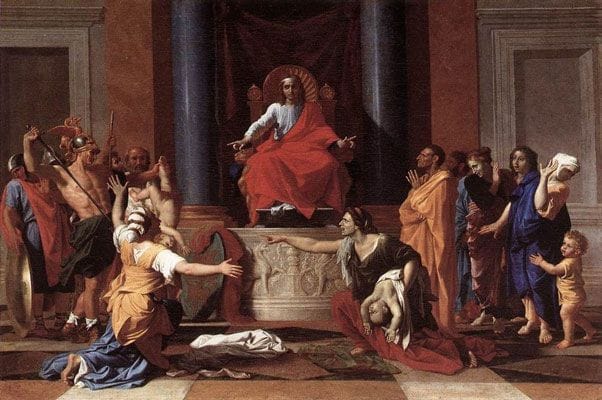
The Judgement of Solomon
Solomon, the third King of Israel, was the son of David and Bathsheba, and was renowned for his wisdom. According to the Old Testament, Solomon has been called to rule on the claims made by two prostitutes (living in the same house) who had given birth at the same time. One of the infants has died (its body is held in the arms of the woman on the right) and the women are contesting the parentage of the living child (held up by the ankle, behind the woman on the left, by a sword wielding soldier). Solomon decrees that the surviving child should be cut in two (each woman taking a half). Upon hearing the judgement, the child's true mother forsakes her maternal claims on the child in order to spare the child's life. This gesture - or maternal cry - reveals the identity of the rightful parent to the wise King Solomon and the child is restored to its just mother.
Symmetric unity is a characteristic of many of Poussin's paintings. We see that here in the way the columns, the door frames, and the base lines of the pavement form a pyramidal composition. The untidy baying factions on either side of the King even form a congruent mirror effect. Meanwhile, King Solomon, in effect the painting's geometric axis, and with his slightly elevated hands, contributes both to the compositional balance and to the thematic element of the painting which alludes to the balance of objective justice. Indeed, Poussin's precise compositional organization creates a sense of closure in the same way Solomon's stoic intelligence has brought judicial closure. In addition to the Biblical narrative, Poussin references Greek and Roman antiquity which is redolent in the clothes, helmets, shields, columns and the frieze that adorns the throne. (There are many preparatory drawings to this painting to be found in various French museums.)
Oil on canvas - Louvre Museum, Paris
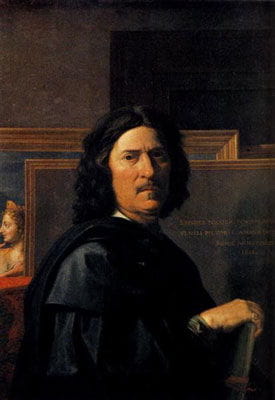
Self-Portrait
Poussin was approached by his friend and patron Paul Fréart de Chantelou to make a portrait for the foundation of the French Academy in 1648. Poussin agreed but, given his general feelings of distain towards his Roman contemporaries, he chose to produce a self-portrait. He produced a first version in 1649 modelled on a friend's tomb (a memento mori) but it is the second that has drawn most interest from historians. Poussin presents himself in a dark gown with a stole thrown over his shoulders. His posture is upright, and his head is turned towards us in almost full-face view. His expression is intense, and the setting is the artist's own studio.
The image is lent a somewhat intangible quality by an arrangement of three framed canvases that provide the painting with a quadratic structure (that structure is merely reinforced by the doorframe in the background). The canvas nearest us is unpainted except for an inscription that reads: "Portrayal of Nicolas Poussin of Les Andalys, done at Rome during the Jubilee Year of 1650, aged 56 years."
To our left, a second canvas shows a woman in front of a landscape. She is wearing a diadem (crown) with what looks like an eye at its centre. Its meaning remains ambiguous, but it has been interpreted as an allegory: painting deserved to be "crowned" the highest of all the arts, and/or as a symbol of Amicitia - a treatise of friendship shared amongst Roman statesmen. A further detail of note is the ring Poussin wears on the little finger of his right hand which rests on a closed portfolio. The stone is cut in a four-sided pyramid: a symbol of the Stoic stability and strength of character. It is, however, Poussin's sadness and emotional vulnerability once he has stepped out from behind the cover (or "shield") of his canvases that leaves the lasting impression of the artist himself.
Oil on canvas - Louvre Museum, Paris
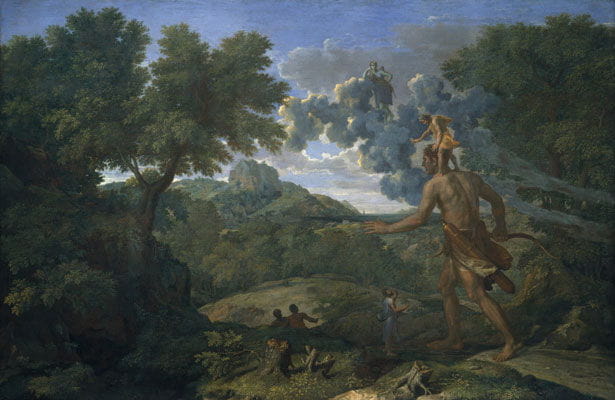
Blind Orion Searching for the Rising Sun
Poussin, who produced Blind Orion at the request of Michel Passart, a collector of art and connoisseur of landscape painting, painted several impressive "late" landscapes. Some of his earlier landscapes, such as Landscape with Saint Jean at Patmos (1640), appear tranquil and orderly. The color scheme in the earlier style too is made up of light blues and rich contrasting colors, with the result that the paintings feel composed and still. In his later paintings, however, Poussin used darker colors and eddying cloud forms to represent more volatile weather conditions. His intention was to show the relationship between the natural environment and the mind and to use nature as a way to communicate difficult or untamed human emotions.
This painting represents the narrative of the blind giant Orion, as told by the Greek writer Lucian (125-180 ACE). Art historian Mary Sprinson de Jesús comments that in this painting Poussin "appears to have surrendered control and lapsed momentarily in his love of order and geometry, permitting his imagination to lead him." We can see this from the richness of the landscape, in which clouds, trees, and hills overwhelm the canvas. The sun named in the title begins to peak over the hill, but from where exactly is unclear. Unlike many of his earlier landscapes, the figures are not foregrounded and do not command our attention in the same way; rather, as Orion seems to be about to move from right to left, the spectator looks towards where he might be headed, rather than focus on his giant form. It is nature therefore that overwhelms the figures and represents through painting a new kind of psychic possibility.
Oil on canvas - The Metropolitan Museum of Art, New York City
Biography of Nicolas Poussin
Childhood and Education
Nicolas Poussin was born near the town in Les Andelys in Normandy in 1594. He was the child of a noble family who had fallen on hard times. He was schooled in many subjects, including Latin and letters, but showed a talent for drawing (he was apparently scolded by his teachers for doodling in his books). The French Baroque painter Quentin Varin came across his work whilst passing through Poussin's town and encouraged him to go into painting professionally. His parents, however, did not agree which led the young Poussin to run away to Paris in 1612 aged eighteen.
On his arrival in Paris he studied many topics, including anatomy and visual perspective, whilst working with more established painters Georges Lallemand and Ferdinand Elle. The trade in art was flourishing at that time, and figures like the Queen of France Marie de' Medici, provided many commissions in order to decorate her palace, while wealthy land owners sought original religious works to decorate their homes. However, Poussin was still very much on the periphery and did not like the studio system which demanded that several individuals worked on the same work. It was in Paris that he was first introduced to Italian Renaissance art, a style that would determine his own artistic destiny.
In the 1620s, his career had started to pick up. In 1622, he received his first commission for the Jesuits, and the following year he was asked to produce a painting to hang in Notre-Dame. The paintings for the Jesuits garnered Poussin some notice in artistic circles, and through them he was employed by the court poet Giambattista Marino to make a series of drawings. This influential commission led to others and when Marino travelled to Rome in 1623, he asked the young painter to join him.
Mature Period
Poussin arrived in Rome in 1624, and would remain (not withstanding a short excursion to Paris) there until his death in 1665. However, his friend and patron Marino died soon after his arrival which left Poussin in financial difficulties. He was also afflicted with syphilis from which he would never fully recover. Despite these early setbacks, Poussin studied at the Italian artist's Domenichino academy, learning to paint nudes and visiting cathedrals and convents in order to study the work of the Italian masters.
Poussin also met Cassiano dal Pozzo, the noted antiquarian and scholar and art patron, and became part of his intellectual circle. Around 1615, along with his younger brother Carlo, Cassiano had begun to develop his Museo Carcaeo (Paper Museum), a compendium that contained classical texts, drawings of antiquities, illustrations of Roman architecture, monuments, and sculpture, all carefully measured and recorded. Attempting to catalog human knowledge, the work also contained prints and illustrations dealing with botany, geology, zoology, as well as cultural customs, traditional clothing and costumes. Dal Pozzo's approach was archeological and scientific, and he shared his work with the many artists and scholars who lived in Rome or studied there for a period of time. He became Poussin's lifelong friend and patron, and the two men, along with other colleagues such as Paul Fréart de Chantelou, shared a profound interest in the archeology of the Roman world and its accurate depiction in art. As Secretary for Cardinal Francesco Barberini, dal Pozzo also played a role in advancing Poussin's career, as Cardinal Barberini commissioned The Death of Germanicus (1627), the artist's first masterpiece, and the Vatican subsequently commissioned The Martyrdom of St. Erasmus (1628-29).
Poussin also made the acquaintance of another Italianized Frenchman, Claude Lorrain (sometimes better known simply as Claude). The men were close neighbors and were in fact both patronized by the neo-stoicist (a combination of Christianity and Classical stoicism) Cardinal Camillo Massimo. Poussin and Claude would embark together on drawing expeditions to the Campagna countryside where they would sketch (and/or paint in Claude's case) the heroic Roman landscape. Claude had already made his reputation as a master of landscape painting and it is generally agreed that Claude, who worked with a greater feel for spontaneity than his more cerebral countryman, helped open Poussin's eyes to the heavenly beauty of nature. Poussin was also closely acquainted with the Baroque poet Giovanni Battista Marino, the printmaker and draftsman Pietro Testa (with whom he shared his interest in ancient history) and the polymath (writer, painter, mathematician and priest) Matteo Zaccolini who was considered a specialist in perspective.
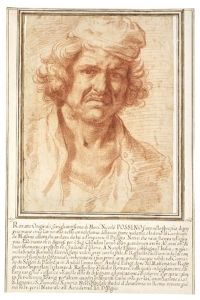
In 1630, Poussin married Anne-Marie Dughet. By 1632 he had earned enough to purchase a small house for them on the Via Paolina. It was a great period of productivity for the painter, despite the fact that he always worked alone and had never established his own studio. During the same period, he ventured into landscape painting, a genre that did not have the same heritage or gravitas as the Biblical and mythological narratives on which he had built his reputation. Indeed, Poussin's digression into landscapes would prove pivotal for the development of the genre. His inspiration came from trips to the Roman countryside though he would still treat it as a backdrop for established literary stories. He completed many of his most famous works - such as Abduction of the Sabine Women (1633-34) and Dance to the Music of Time (1636) - during this period. Poussin's new fame led him to shun public life, however, and he preferred to work on commissions from private collectors rather than state or church projects.
News of Poussin's growing reputation carried throughout the continent and he received commissions from several members of Parisian high society. For instance, he was commissioned by Cardinal Richelieu to paint two separate paintings, The Triumph of Pan and The Triumph of Bacchus (to be hung in his house rather than in a church). In 1639 he received an invitation to move to Paris to work for King Louis XIII though he was reluctant to be uprooted from Rome. It was only on the King's command that Poussin left Italy for France, arriving in December 1640. Named First Painter to the King, his main tasks were to decorate the royal residence, to execute designs for The Long Gallery of the Louvre and to paint altarpieces for the King and members of his court. Working with a large team of assistants, Poussin became frustrated at his lack of autonomy and the peculiar mixture of the King's demands. Poussin eventually managed to arrange a return to Italy in 1642. Indeed the death of Richelieu in December of that year, and the death of the King himself only four months later, meant that Poussin was absolved of any future obligation to return to the French court.
Later years
On his return to Rome, Poussin found that many of his former clients had died, though he was sustained financially by a growing number of French patrons. As Poussin grew older, he became more reclusive and was known to be rather cantankerous, and intolerant of other painters. He did however champion the work of Frenchman Charles Le Brun, a painter with whom he worked for four years. An artistic prodigy who had already received commissions in France at the age of fifteen, Le Brun was deeply influenced by Poussin's classicism and his emphasis on form and drawing. He became a lifelong advocate for Poussin's approach, which he developed into the ideal of the Royal Academy of Painting and Sculpture which he founded in 1648.
By 1650, Poussin's health had started to decline. It is estimated that he still painted four paintings a year but he was beginning to suffer hand tremors. In the years leading up to his death, Poussin restricted his output to landscapes, including Landscapes with Pyramus and Thisbe (1651) and the series The Four Seasons (1660-64). In this ambitious series, Poussin used figures from the Old Testament in each canvas to represent individual seasons. In these works especially, Poussin used his wide-reading and search for complex representation in order to produce works that were rich in cultural and emotional significance, while still showing the inherent harmony of nature.
After the death of his wife in 1664, Poussin's health rapidly deteriorated and he died in 1665 at the age of 71. In his final will and testament he specified that he did not want an elaborate funeral, reflective of his life-time interest in Stoicist philosophy. The city of Rome was saddened by his death and there followed a large procession to the church of San Lorenzo in Lucia where the great adopted Frenchman was buried.
The Legacy of Nicolas Poussin
Following Poussin's death in 1665, his work continued to be very influential as Le Brun, by now the leading artist in France, continued to champion his classical approach. Le Brun presented a lecture in 1668 on Poussin's Eliezer and Rebecca (1648) as exemplifying the "harmonic proportions of the ancients." In 1671 at the Royal Academy of Painting and Sculpture, he entered into a dispute with critic Roger de Piles over the importance of line - not only drawing but design and depicting form - versus the importance of color. What Le Brun called the "Poussinist" approach viewed color as decorative and secondary to the subject, and one could find precedents in the work of those painters who followed the themes of antiquity, such as Raphael. De Piles championed rather the work of the Flemish artist Peter Paul Rubens who emphasized color as essential to emotionally expressive composition. The debate continued for years, though eventually the Rubenists won the debate, when de Piles became a member of the French Academy in 1699. The victory was affirmed when Antoine Watteau's masterpiece, The Embarkation for Cythera (1717) was accepted by the Academy and launched the Rococo period, thus favoring the supremacy of color. However, Poussin's counterposition was to resound on future aesthetic deliberations in French painting.
Poussin's tendency to draw on mythology and the force of nature rather than contemporary events meant that his influence was particularly felt by prominent Neoclassicists including Jacques-Louis David and Jean-Auguste-Dominique Ingres. David, for example, attentively studied his paintings with the aim of learning how to best blend figures within classic allegories. For his painting The Oath of the Horatii (1784), David looked to Poussin's The Abduction of the Sabine Women for insights into how to fully embody some of his male characters. Ingres, meanwhile, believed that Poussin was "the first, and only [painter] to capture the nature of Italy" and that when faced with a beautiful landscape "one says, and says correctly, that it is 'Poussinesque'."
Moving into the 20th century, Poussin has featured in comparative exhibitions alongside the likes of Paul Cézanne (who had claimed that Poussin's paintings had given him "a better knowledge of who I am") and Cy Twombly. The Abduction of the Sabine Women was a direct source of inspiration for Pablo Picasso, a painter who was known to have admired Poussin's compositional precision. In 1963, the 82-year-old Picasso painted Rape of the Sabine Woman - a self-conscious Cubist reworking (believed to be a comment by him on the Cuban Missile Crisis) of Poussin's masterpiece. More recently still, the American abstract painter Twombly has invoked Poussin through his work. Though his spare abstract paintings do not include figures, or indeed any representational forms, like Poussin, Twombly looked to Greek and Roman mythology, and ancient symbolism, for inspiration. Indeed, Twombly produced his own cycle of four paintings representing the seasons, Quattro Stagioni (1993-94), which can be read as a revision of Poussin's series. Twombly had in fact followed in the footsteps of Markus Lüpertz who, between 1987-90, had produced a series of paintings in Poussin's honor. In her analysis of his painting Poussin-Philosph (1990), for instance, Carolina Andrada Páez argued that through "his interpretation of Poussin, Lüpertz [discovered] a pictorial freedom bound up with the mythological" and that Lüpertz's postmodern "interpretation" of Poussin was "associated with [Poussin's] sense of philosophical investigation" and this had become "a contemporary theme" for future Lüpertz works.
Influences and Connections

- Domenichino
- Jacques Stella
- Jacques Stella
- Charles Le Brun
 Ask The Art Story AI
Ask The Art Story AI












